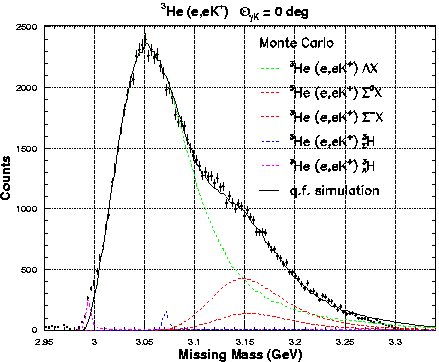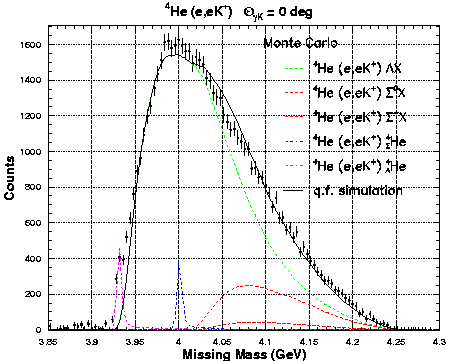| Electroproduction of Kaons and Light Hypernuclei | |||
|---|---|---|---|
| F. Dohrmann1,2 for the Jefferson Laboratory Experiment E91-016 collaboration | |||
|
Jefferson Laboratory experiment E91-016, ``Electroproduction of Kaons and Light
Hypernuclei'' is a study of quasifree production of Kaons on targets of H,
D, 3He, 4He, Carbon and Aluminum, at an incident electron
energy of 3.245 GeV. For H and D targets, data were also obtained at
E = 2.445 GeV. The scattered electron e¢ and emergent K+ were detected
in coincidence with the use of the HMS and SOS spectrometers, respectively,
in Hall C of Jefferson Laboratory. Angular distributions for the (e,e'K+)Y reactions were
measured at forward angles with respect to the virtual photon for
Q2 @ 0.35 GeV2. Particle identification utilizing
time-of-flight detectors together with Aerogel Cerenkov detectors yields
clean missing mass spectra [1], and allows
subtraction of random backgrounds. The experiment was run in two time
periods. The H and D targets were studied near the end of 1996 while the
balance of the experiment, namely the 3,4He targets were bombarded
in the fall of 1999 when the FZR also collaborated on running the
experiment. More than 1.4 TB of data were taken during that time.


Fig. 1 Preliminary missing mass spectra for 3He and 4He(e,e¢K+) reactions for a relative angle of 0 deg in the lab between the virtual photon and the Kaon. The various Monte-Carlo simulations for the quasi-free contributions as well as their sum (solid line) are shown. They are preliminary and relatively crude. The location of ``bound L and S'' states is shown merely to suggest possible locations. It should be emphasized that much more analysis is required.
For D, it is known that there is no bound L-nucleon state, but for
both 3He and 4He targets we anticipate evidence for a
bound hypernuclear states. Although the data shown in the figure are quite
preliminary, it appears that bound L hypernuclear states are seen.
The possibility of bound S hyper-nuclei also exists, but it is
conjectural at this time. Construction of an optimal Monte-Carlo simulation
will require considerably more effort before any conclusions can be drawn.
The large number of final state configurations results in complications
that must be analyzed prior to extracting final cross sections.
1
FZR and Physics Division, Argonne National Laboratory, Argonne,
Illinois 60439, USA
|